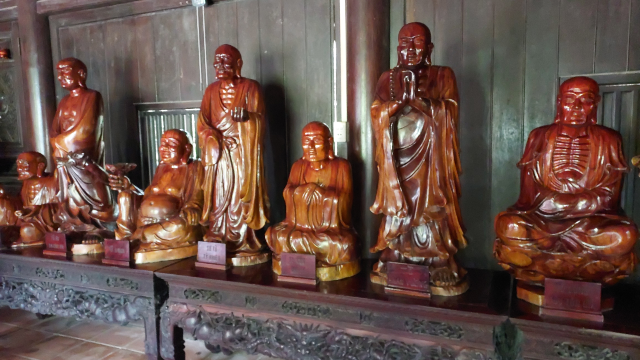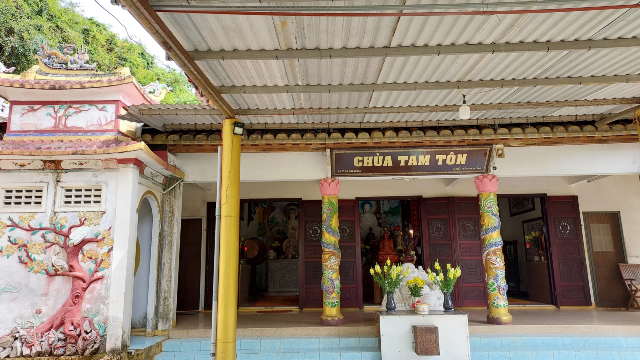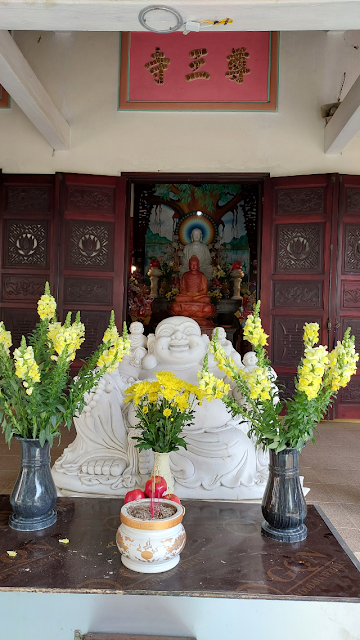Turning left from the relaxation area is Tam Thai pagoda. Not a very big pagoda but it is one of the oldest.
History:
- The written account of this pagoda state that it was built in 1630 under Le dynasty and Hung Lien, a Chinese monk became the abott
- Tay Son period (1717-1802) was a devastating period and the pagoda was completely damaged.
- It was rebuilt under King Minh Mang dynasty and was renamed Quoc Tu in 1825.
- It was again rebuilt during Nguyen dynasty and was declared a national pagoda.
Architecture:
- The art work is something which one needs to spend some time on. Like Linh Ung Pagoda, small multicolored porcelain tiles have been used to decorate pagoda.
- The entrance gate( a climb from gate 1) to pagoda is through a 3-door gate, the middle gate is only for monks, left one is for men and the right one for women. We went to the compound through the side of pagoda.
 sign board pointing to pagoda
sign board pointing to pagoda Tam Tai Pagoda
Tam Tai Pagoda
Entrance gate:
Tam Quan gate(view from outside)
The middle gate is only for the monks, left one is for men and right for women.
Tam Quan gate(view from the pagoda side)
The place where usually a bell is placed is a stele in white stone.
Phật Di Lặc is seen in front of the stele. I could not find out the details of of writings.
The roof is beautifully decorated with flaming moon in the center flanked by dragons. This is considered a distinctive architectural feature of the Nguyen period.
Below the roof are scenes from the life of Buddha.
Either side of entrance to main hall is guarded by stone lions.carved lions at entrance
Standing just outside the gate, is a heritage tree said to be more than 200 years. The ends of curved roof are decorated with dragons and a turtle.
Amitabha Buddha
Sakyamuni Buddha
a monk praying at the altar
decorated columns of pagoda
Behind the carved lions are decorated wall on either side
the heritage tree standing tall
Very close to the tree, a flight of steps takes to another tower pagoda.
dragon with a pearl in mouth by the side of steps
a tower and Guanyin on the side
Tam Tai Pagoda below
Dhammapada sutra stone by side of steps
Ton Tam Pagoda:
Close to Tam Thai is Ton Tam pagoda. There are three buildings-- one is the living quarters for monks and 2 buildings are temples.
private property of pagoda
The first building with lions outside is a part of residential quarter.
place for having food
wooden statues by the side of wall
living quarters
roof of living quarters
8-armed Guanyin
Phật Di Lặc, Laughing Buddha outside the main hall
Buddha image in the center
Kshitigarbha Buddha
Guanyin
on the side of main altar
bell inside the temple
Temple of Guanyin:
Opposite Ton Tam pagoda, an image of Guanyin stands under a pavilion.
can you spot a caterpillar?😃
Tu Tam Pagoda:
Going down the steps is the Tu Tam Pagoda.
way to Tu Tam pagoda
we side tracked and sat beside the image of Guanyin for some time looking at the view below.
below is a garden which is maintained by the monks. We got lost and missed the way to pagoda.
View of pagoda from the road which we saw later. The Vong Giang Dai, viewing point is on the right side.
Vong Giang Dai:
Behind the Guanyin, a way goes up to the viewing point. It is located on the south-west slope of Thuy Son mountain. The platform is 7 meter wide.
Co Co river can be seen at a distance below
In the center, is Tra Kieu stone slab which is about 2 meter high. It is engraved with 3 big Chinese characters: Vong Giang Dai. Beneath it is Minh Mang 18th year 7th lunar month, 1837.
View of mountains of Kim Son (higher one) and Hoa Son (lower one)
In the center, is Tra Kieu stone slab which is about 2 meter high. It is engraved with 3 big Chinese characters: Vong Giang Dai. Beneath it is Minh Mang 18th year 7th lunar month, 1837.
View of mountains of Kim Son (higher one) and Hoa Son (lower one)
view of part of Tu Tam pagoda below
where to next?
We return to relaxation area, then to Hoa Nghiem and Huyen Khong Cave.





































































No comments:
Post a Comment
Thanks for visiting my blog. Your feedback is always appreciated.